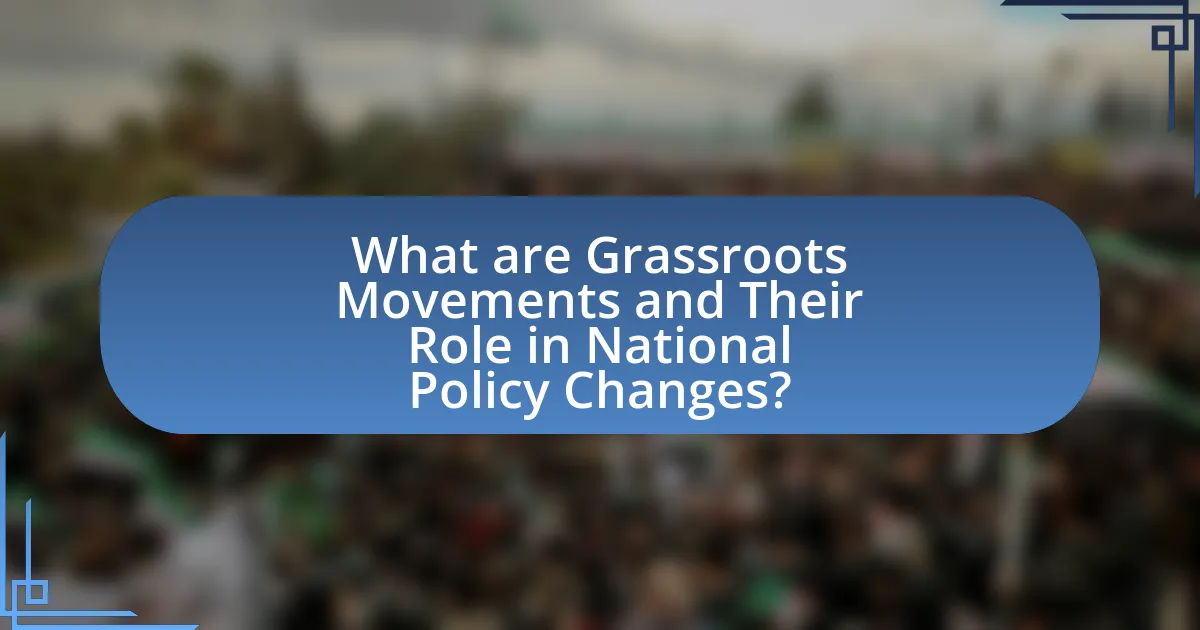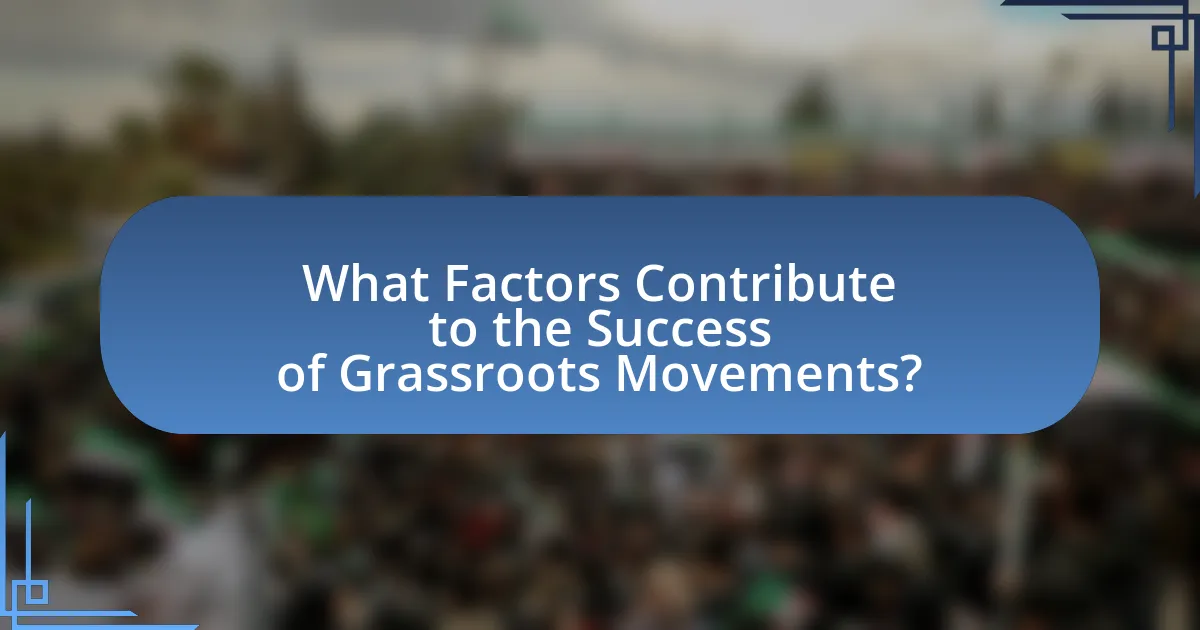Grassroots movements are organized efforts by ordinary individuals aimed at achieving social or political change, often starting at the local level and influencing national policy. This article explores the mechanisms through which grassroots movements initiate policy changes, including community mobilization, social media engagement, and coalition-building. It highlights historical examples such as the Civil Rights Movement and the Women’s Suffrage Movement, illustrating their significant impact on legislation. Additionally, the article discusses the challenges these movements face, strategies for overcoming obstacles, and the outcomes of successful grassroots activism on national policy.

What are Grassroots Movements and Their Role in National Policy Changes?
Grassroots movements are organized efforts by ordinary people to effect social or political change, often at the local level, which can influence national policy changes. These movements mobilize community members to advocate for specific issues, leveraging collective action to raise awareness, apply pressure on policymakers, and drive legislative reforms. Historical examples include the Civil Rights Movement in the United States, which led to significant policy changes such as the Civil Rights Act of 1964, demonstrating how grassroots activism can reshape national legislation.
How do grassroots movements initiate change in national policies?
Grassroots movements initiate change in national policies by mobilizing community members to advocate for specific issues, thereby influencing public opinion and policymakers. These movements often utilize strategies such as organizing protests, leveraging social media campaigns, and building coalitions to amplify their message. For instance, the Civil Rights Movement in the United States effectively utilized grassroots organizing to challenge segregation laws, leading to significant legislative changes like the Civil Rights Act of 1964. This demonstrates that grassroots efforts can create substantial pressure on national leaders to enact policy reforms that reflect the demands of the populace.
What strategies do grassroots movements employ to influence policymakers?
Grassroots movements employ strategies such as mobilizing community support, leveraging social media, and engaging in direct lobbying to influence policymakers. Mobilizing community support involves organizing local events and rallies to demonstrate public backing for specific issues, which can attract media attention and pressure policymakers to respond. Leveraging social media allows grassroots movements to disseminate information rapidly, engage a wider audience, and create viral campaigns that can sway public opinion and, consequently, policymakers. Direct lobbying includes meeting with legislators, providing testimonies, and presenting research or data to advocate for policy changes, which has been shown to be effective in influencing legislative outcomes, as evidenced by the success of movements like the Women’s March in advocating for women’s rights and policy reforms.
How do grassroots movements mobilize community support for policy changes?
Grassroots movements mobilize community support for policy changes by fostering local engagement and building coalitions that amplify collective voices. These movements often utilize strategies such as community organizing, social media campaigns, and public demonstrations to raise awareness and galvanize public opinion. For instance, the Black Lives Matter movement effectively mobilized support through social media platforms, leading to widespread protests and policy discussions on police reform. Research indicates that grassroots efforts can significantly influence legislative outcomes; a study by the Stanford Social Innovation Review found that grassroots advocacy led to a 20% increase in the likelihood of policy adoption in various cases. This demonstrates that grassroots movements are crucial in shaping public policy by mobilizing community support.
Why are grassroots movements significant in the context of national policy?
Grassroots movements are significant in the context of national policy because they mobilize community engagement and influence decision-making processes. These movements often represent the voices of marginalized groups, bringing attention to issues that may be overlooked by traditional political structures. For instance, the Civil Rights Movement in the United States effectively shifted national policy by advocating for racial equality and justice, leading to landmark legislation such as the Civil Rights Act of 1964. This demonstrates how grassroots activism can create substantial changes in national policy by raising awareness, fostering public support, and pressuring lawmakers to act.
What historical examples illustrate the impact of grassroots movements on policy?
Grassroots movements have significantly influenced policy changes throughout history, with notable examples including the Civil Rights Movement in the United States and the Women’s Suffrage Movement. The Civil Rights Movement, particularly from the 1950s to the 1960s, mobilized citizens to demand equal rights and led to landmark legislation such as the Civil Rights Act of 1964 and the Voting Rights Act of 1965, which outlawed discrimination and protected voting rights for African Americans. Similarly, the Women’s Suffrage Movement, culminating in the passage of the 19th Amendment in 1920, was driven by grassroots activism that advocated for women’s right to vote, fundamentally altering the political landscape in the U.S. These movements exemplify how organized citizen efforts can lead to substantial legislative changes and reshape national policies.
How do grassroots movements differ from traditional lobbying efforts?
Grassroots movements differ from traditional lobbying efforts primarily in their approach to influence policy. Grassroots movements mobilize large groups of individuals at the community level to advocate for change, often relying on collective action and public engagement, while traditional lobbying involves direct interaction with policymakers by professional lobbyists representing specific interests or organizations.
For instance, grassroots movements often utilize social media and public demonstrations to raise awareness and build support, as seen in movements like Black Lives Matter, which gained traction through widespread public participation and online activism. In contrast, traditional lobbying typically involves formal meetings, financial contributions, and strategic communication aimed at influencing legislators directly, as exemplified by organizations like the American Medical Association, which employs lobbyists to advocate for healthcare policies.
This distinction highlights how grassroots movements emphasize broad public participation and community-driven initiatives, whereas traditional lobbying focuses on elite access and negotiation with decision-makers.

What Factors Contribute to the Success of Grassroots Movements?
The success of grassroots movements is primarily influenced by community engagement, effective communication, and strategic organization. Community engagement fosters a sense of ownership and commitment among participants, which is crucial for mobilizing support and sustaining momentum. Effective communication ensures that the movement’s goals and messages resonate with a broader audience, often utilizing social media platforms to amplify reach. Strategic organization involves planning and executing actions that align with the movement’s objectives, such as protests, petitions, or lobbying efforts.
For instance, the Civil Rights Movement in the United States successfully utilized grassroots strategies, including local organizing and national campaigns, to achieve significant policy changes like the Civil Rights Act of 1964. This historical example illustrates how these factors—community involvement, clear messaging, and organized efforts—can lead to impactful outcomes in national policy changes.
How does public engagement affect the effectiveness of grassroots movements?
Public engagement significantly enhances the effectiveness of grassroots movements by increasing visibility, fostering community support, and amplifying collective voices. When individuals actively participate in grassroots initiatives, they contribute to a larger network that can mobilize resources, share information, and create a unified front. For instance, the 2017 Women’s March, which drew millions of participants worldwide, exemplified how public engagement can elevate issues like women’s rights and social justice to national discourse, influencing policy discussions and legislative actions. Research indicates that movements with higher public engagement levels are more likely to achieve their goals, as demonstrated by the success of the Black Lives Matter movement in raising awareness and prompting policy changes regarding police reform.
What role does social media play in mobilizing grassroots movements?
Social media serves as a crucial tool for mobilizing grassroots movements by facilitating rapid communication, organization, and outreach among supporters. It enables activists to share information, coordinate events, and amplify their messages to a broader audience, often leading to increased participation and engagement. For instance, the Arab Spring demonstrated how platforms like Twitter and Facebook were instrumental in organizing protests and disseminating real-time updates, ultimately influencing political change in several countries. Additionally, studies show that social media can enhance the visibility of grassroots issues, allowing movements to gain traction and attract media attention, which further legitimizes their causes and pressures policymakers to respond.
How do grassroots movements build coalitions with other organizations?
Grassroots movements build coalitions with other organizations by identifying shared goals and values, fostering collaboration through mutual support and resource sharing. These movements often engage in outreach to like-minded organizations, facilitating dialogue and establishing partnerships that enhance their collective impact. For example, the Civil Rights Movement in the 1960s successfully allied with labor unions and religious groups, which amplified their advocacy efforts and led to significant policy changes, such as the Civil Rights Act of 1964. This historical context illustrates how strategic alliances can strengthen grassroots initiatives and influence national policy.
What challenges do grassroots movements face in influencing national policy?
Grassroots movements face significant challenges in influencing national policy, primarily due to limited resources, lack of access to decision-makers, and opposition from established political entities. Limited financial and human resources hinder their ability to mobilize effectively and sustain campaigns, as evidenced by studies showing that well-funded organizations often dominate policy discussions. Additionally, grassroots movements frequently struggle to gain direct access to policymakers, who may prioritize the interests of larger, more established groups. For instance, a report by the National Democratic Institute highlights that grassroots organizations often lack the lobbying power and connections necessary to influence legislative agendas. Furthermore, established political entities may actively resist grassroots initiatives, viewing them as threats to their power, which can lead to pushback and attempts to undermine their efforts. These factors collectively impede the ability of grassroots movements to effect meaningful change in national policy.
How do political opposition and institutional barriers impact grassroots efforts?
Political opposition and institutional barriers significantly hinder grassroots efforts by limiting access to resources, creating legal obstacles, and suppressing public support. Grassroots movements often rely on community engagement and mobilization, but when faced with political opposition, such as unfavorable legislation or government resistance, their ability to organize and advocate effectively is compromised. For instance, in the United States, the 2010 Citizens United v. FEC ruling allowed for increased corporate influence in politics, which has made it more challenging for grassroots organizations to compete for attention and funding. Additionally, institutional barriers like bureaucratic red tape can delay or prevent grassroots initiatives from gaining traction, as seen in various environmental movements where permits and regulations slow down action. These factors collectively diminish the impact of grassroots movements on national policy changes, as they struggle to overcome the challenges posed by established political structures and opposition.
What strategies can grassroots movements use to overcome these challenges?
Grassroots movements can overcome challenges by employing strategies such as building coalitions, leveraging social media, and engaging in community organizing. Building coalitions allows these movements to unite diverse groups, increasing their collective power and resources, as seen in the success of the Women’s March, which brought together various organizations to advocate for women’s rights. Leveraging social media enables grassroots movements to amplify their messages and mobilize supporters quickly; for instance, the #BlackLivesMatter movement effectively utilized platforms like Twitter to raise awareness and drive action. Engaging in community organizing fosters local support and empowers individuals to take action, exemplified by the success of the community-led initiatives in the Fight for $15 campaign, which advocated for a higher minimum wage. These strategies collectively enhance the effectiveness of grassroots movements in influencing national policy changes.

What are the Outcomes of Successful Grassroots Movements on National Policy?
Successful grassroots movements can lead to significant changes in national policy, including the enactment of new laws, shifts in public opinion, and increased political engagement. For example, the Civil Rights Movement in the United States resulted in landmark legislation such as the Civil Rights Act of 1964 and the Voting Rights Act of 1965, which dismantled institutional racism and expanded voting rights. Additionally, grassroots movements often raise awareness about specific issues, influencing policymakers to prioritize these concerns in their agendas. The Women’s March in 2017 mobilized millions and highlighted issues like gender equality and reproductive rights, prompting discussions in Congress and among state legislatures. These outcomes demonstrate that grassroots movements can effectively shape national policy by mobilizing public support and pressuring political leaders to act.
How do grassroots movements lead to tangible policy changes?
Grassroots movements lead to tangible policy changes by mobilizing community support, raising awareness, and influencing decision-makers. These movements often begin at the local level, where individuals unite around shared concerns, such as social justice or environmental issues. For example, the Civil Rights Movement in the United States effectively utilized grassroots organizing to challenge discriminatory laws, resulting in significant legislative changes like the Civil Rights Act of 1964. Additionally, grassroots campaigns can leverage social media to amplify their message, engage a broader audience, and apply pressure on policymakers. Research shows that when a substantial number of constituents advocate for specific policies, elected officials are more likely to respond due to the need to maintain public support and electoral viability.
What specific policies have been influenced by grassroots movements in recent years?
Grassroots movements have significantly influenced policies such as the Green New Deal, criminal justice reform, and the push for universal healthcare. The Green New Deal, primarily advocated by the Sunrise Movement, aims to address climate change and economic inequality, gaining traction in Congress and among Democratic candidates. Criminal justice reform has been propelled by movements like Black Lives Matter, leading to policy changes in police funding and accountability measures in various states. Additionally, the Medicare for All campaign, supported by grassroots organizations, has sparked discussions and proposals for universal healthcare at the national level, influencing Democratic Party platforms. These examples illustrate the tangible impact of grassroots activism on shaping national policy agendas.
How do grassroots movements affect public perception and awareness of issues?
Grassroots movements significantly influence public perception and awareness of issues by mobilizing communities and amplifying marginalized voices. These movements often utilize social media and local organizing to disseminate information, thereby increasing visibility for specific causes. For instance, the Black Lives Matter movement has raised awareness about systemic racism and police brutality, leading to widespread public discourse and policy discussions. Research indicates that grassroots campaigns can shift public opinion; a study by the Pew Research Center found that public awareness of climate change increased by 20% in areas with active grassroots environmental organizations. This demonstrates that grassroots movements play a crucial role in shaping societal attitudes and driving awareness around critical issues.
What lessons can be learned from successful grassroots movements?
Successful grassroots movements demonstrate the importance of community engagement and collective action in driving social change. These movements often highlight the effectiveness of mobilizing local support to influence national policy, as seen in the Civil Rights Movement, which utilized grassroots organizing to achieve significant legislative changes like the Civil Rights Act of 1964. Additionally, successful grassroots efforts emphasize the need for clear messaging and strategic communication to resonate with a broader audience, as evidenced by the Women’s March, which effectively united diverse groups around common goals. Furthermore, these movements illustrate the power of persistence and adaptability, as they often face opposition but continue to evolve their strategies to maintain momentum and achieve their objectives.
What best practices can emerging grassroots movements adopt for success?
Emerging grassroots movements can adopt several best practices for success, including building a strong community base, leveraging social media for outreach, and establishing clear goals. A strong community base fosters trust and engagement, which are essential for mobilizing support; for instance, the Black Lives Matter movement effectively utilized local chapters to create a network of activists. Leveraging social media allows movements to reach a broader audience quickly; studies show that campaigns utilizing platforms like Twitter and Facebook can increase visibility and engagement significantly. Establishing clear, actionable goals helps maintain focus and measure progress, as seen in the successful campaign for marriage equality, which outlined specific legislative objectives. These practices collectively enhance the effectiveness and sustainability of grassroots movements in influencing national policy changes.
How can grassroots movements sustain momentum after achieving policy changes?
Grassroots movements can sustain momentum after achieving policy changes by maintaining active engagement with their supporters and continuously advocating for further reforms. This involves organizing regular events, leveraging social media for communication, and creating coalitions with other organizations to amplify their message. For instance, the Women’s March, which began as a response to the 2016 U.S. presidential election, has successfully mobilized millions annually, demonstrating the effectiveness of sustained activism. Additionally, research by the Stanford Social Innovation Review indicates that movements that establish clear, ongoing goals beyond initial policy changes are more likely to maintain engagement and influence.
What practical steps can individuals take to support grassroots movements?
Individuals can support grassroots movements by actively participating in local initiatives, volunteering time, and donating resources. Engaging in community events, attending meetings, and spreading awareness through social media amplifies the movement’s message. Research shows that grassroots movements, such as the Civil Rights Movement, gained momentum through local involvement and public support, leading to significant policy changes. By contributing to these efforts, individuals can help create a collective impact that influences national policy.


